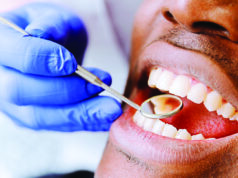Female Genital Mutilation (FGM) is a barbaric cultural practice that has stood the test of time irrespective of the health risks it exposes its victims to.
Female genital cutting – also called female circumcision and female genital mutilation – involves cutting some part of the clitoris and/or labia, with known implications for obstetric outcomes, according to a 2006 World Health Organisation Study Group on FGM.
Besides regulation and countless fused efforts to curtail the practice, most societies, especially the Sabiny and Pokot in Uganda, have failed to give up the practice, writes Arthur Matsiko.
Aged 18, Judith Yapmungusho’s genitals were cut. Nine years later, her legs became paralysed after giving birth to her third-born child.
The “unforgettable pain” she involuntarily underwent in 1976 has forced her to move in a wheelchair for more than three decades.
“When I became paralysed, I developed hatred for my parents because they initiated me into the practice against my will.
They never even told me that the practice had any danger,” she says. “But when I realised their intention was to make me acceptable in the community as the practice dictates, I forgave them.”
Activism
As an activist against FGM, she talks openly about and condemns the practice that is considered a taboo in many countries.
The mother of five boys says she confirmed what paralysed her after consulting medics at Nsambya and Mulago hospitals in the early 1990s.
Compelled by the desire to protect other girls against the dreadful practice, the 70-year-old resident of Tegeres village, Chema sub-county in Kapchorwa district, joined Kapchorwa Active Youths Association (Kaya) to spread information about dangers of this injurious cultural practice.
Kaya is a youth’s cultural group committed to cause social change through theatre.
The most unfortunate incident she has lived to remember is that the two girls with whom she was mutilated got paralysed and died a few years later. As an activist, Yapmungusho shared her testimony during the first-ever national symposium on FGM on December 8, 2015 at Hotel Africana.
The symposium, which was prearranged by the Ministry of Gender, Labour and Social Development, with support from the United Nations Population Fund (UNFPA) and the United Nations Children’s Fund (UNICEF), was organised under the theme: “Time to intensify national action for accelerated FGM/C abandonment in Uganda.”
Political, religious views
In the fight against FGM, Speaker of the Parliament, Rebecca Kadaga, argues that local government leaders in the affected districts should always include the progress on the campaigns in their annual reports.
“I think if you bring it up every year at the district council, people will be monitoring and they will be able to help you make assessments on this matter,” she says.
Kadaga also appeals to donors to establish some shelters from where girls could camp and escape the knife when the cutting season comes.
“We need a new thinking generation of men, boys and women who do not believe in FGM,” says Kadaga, appealing to religious leaders to disseminate the message to their respective congregations.
During the symposium, Archbishop of the Church of Uganda, Stanley Ntagali, appealed to the elders who are forcing girls and women into FGM to “change and allow the young people enjoy their lives”.
“As church, we feel that all people of God, guided by the biblical perspective, created by God in His image, [should] enjoy the benefits of having all their parts of the body; so, FGM degrades the position of girls and women.
As you know medically there are some complications,” said Ntagali. “I want to appeal to the people in those areas of Karamoja and Sebei to change from that cultural position because culture is not static.”
FGM as a crime
Even though the national prevalence of FGM in Uganda is at 0.3 per cent, the Uganda Demographic and Health (UDHS) 2016 indicates that 55 per cent of Ugandan women aged 15-49 have heard of female circumcision.
The survey also reveals FGM is commonly practiced in the Karamoja sub region, with 6.4 per cent of women having undergone the knife.
Meanwhile, the enactment of the Prohibition of Female Genital Mutilation Act, 2010 criminalises the practice. Section 2 states that: “A person who carries out genital mutilation commits an offence and is liable on conviction to imprisonment not exceeding ten years.”
One of the victims of this legislation, Namuton Namon, was sentenced to 10 years in jail in Moroto Prison by the then Moroto Chief Magistrate Moses Mutazindwa.
The 45-year-old Namon then had pleaded guilty to seven accounts of procuring FGM.
In January 2019, police arrested 19 people for allegedly aiding FGM in eastern Uganda after media reported that 400 women were being forcefully mutilated by gangs in the region.
The suspects were taken into custody following joint military and police operations in the Sebei district of Kween.
By all means, this was contrary to Article 5 of Protocol to the African Charter on Human and Peoples’ Rights on the Rights of Women in Africa, 2003.
It stipulates: “State Parties shall prohibit and condemn all forms of harmful practices which negatively affect the human rights of women and which are contrary to recognised international standards.
States Parties shall take all necessary legislative and other measures to eliminate such practices including prohibition, through legislative measures backed by sanctions, of all forms of female genital mutilation…”
Although Uganda is observing legal provisions against such ferocious cultural norms, it is too late for Yapmungusho to get justice because she can hardly remember those who deprived her of her full health at the watchful eye of her parents.
Health risks
FGM comprises various procedures which remove or damage the external female organs for no medical reason.
According to Dan Raisel et al, it is increasingly recognised that FGM causes complications throughout the lifespan.
These are broadly divided into three main areas: gynecological, obstetric and psychological (including sexual function).
“One study has suggested a link between more extensive FGM and primary infertility,” reads part of the 2014 article published in the midlife health journal Maturitas.
According to Dr Edward Tamale Sali, founder of Women’s Hospital International and Fertility Centre, FGM can cause infections that may lead to infertility.
“First of all, FGM is done in a septic kind of environment and when women bleed, they get infections on the vulva, and that infection goes into the vagina, uterus and blocks the fallopian tubes,” says Dr Sali, adding that all this because those who do FGM don’t use antibiotics.
Mutilated women also face difficulties during childbirth because the vagina is too small and too tight to allow for natural childbirth.
Sometimes, Dr Sali says, you may need to cut the vulva to increase the size of the vagina. Although he condemns FGM as a “primitive act”, he advises mutilated expectant mothers to always opt for caesarian section.
Although FGM is done primarily to tame sexual promiscuity by removing the most sensitive part of the vagina, Dr Sali says sexual urge starts from the brain. “They think if you remove the clitoris, you deprive the woman of sexual urge. This is actually false because sexual urge doesn’t come from clitoris, it comes from the brain,” he says.
The World Health Organisation (WHO) recognises and condemns FGM as a harmful practice with short-term and long-term health risks.
Among its long-term effects is Human Immunodeficiency Virus (HIV).
Given that the transmission of HIV is facilitated through trauma of the vaginal epithelium which allows the direct introduction of the virus, it is reasonable to presume that the risk of HIV transmission may be increased due to increased risk for bleeding during intercourse, as a result of FGM.
Amidst other gruesome consequences of the practice, Yapmungusho is living with permanent disability.
The tight fight
The Prohibition of FGM Act, 2010 is one of the milestones in the fight towards FGM.
However, its implementation could face bottlenecks since such cultural practices cannot be eliminated easily.
Meanwhile, various stakeholders such as the UNFPA continue to support the government and other partners in this tight fight.
The UNFPA has supported awareness on the national laws and policies on FGM including the Prohibition of FGM Act 2010, The Constitution, East African FGM Legislative Bill (EALA), cross border resolutions, UN Security Council Resolutions 2012 and 2015, and The AU agenda 2063, among others.
This includes support to surveillance and community policing including across borders, as well as translation of FGM laws into local languages – Pokot and Kupsabiny – and distribution.
Alain Sibenaler, the UNFPA country representative to Uganda, told us the agency has always provided support to cultural institutions including the clans, elders and opinion leaders on FGM abandonment, and exploring alternative rites of passage.
“This includes support to commemorate Culture days such as the Sabiny, Pokot, Tepeth and related events in the communities to celebrate and promote the positive aspects of cultures, and denounce FGM and harmful practices,” said Sibenaler. “During these community events, FGM public declarations are made and practices promoting Social norms of keeping girls and women uncut are encouraged.”
Consequently, such initiatives have played a tremendous role towards the reduction in the prevalence of FGM from 1.4 per cent in 2011 to 0.3 per cent in 2016.
Despite her current physical stature, Yapmungusho tells her story with a grin. She believes speaking the truth, and especially within her region, would steer the efforts towards curbing the practice.





















